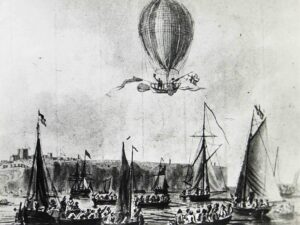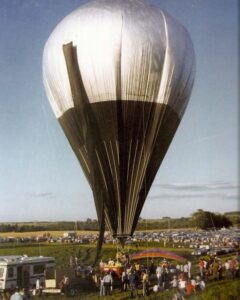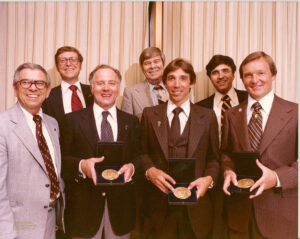 Even before the first airplane too flight, there were people who wanted to be airborne. Human flight first became a reality in the early 1780s with the successful development of the hot-air balloon by French papermaking brothers Joseph and Etienne Montgolfier. Soon balloons were being filled with lighter-than-air gas, such as helium or hydrogen, to provide buoyancy. It was a whole new era. Finally, on November 21, 1783, the first manned hot air balloon took flight. Man could be airborne and come back to earth safely. With that, came the natural desire to try to go higher and further. Man was not done with flight, and in fact this was just the beginning.
Even before the first airplane too flight, there were people who wanted to be airborne. Human flight first became a reality in the early 1780s with the successful development of the hot-air balloon by French papermaking brothers Joseph and Etienne Montgolfier. Soon balloons were being filled with lighter-than-air gas, such as helium or hydrogen, to provide buoyancy. It was a whole new era. Finally, on November 21, 1783, the first manned hot air balloon took flight. Man could be airborne and come back to earth safely. With that, came the natural desire to try to go higher and further. Man was not done with flight, and in fact this was just the beginning.
An early achievement of ballooning came in 1785 when Frenchman Jean-Pierre Blanchard and American John Jeffries became the first to cross the English Channel by air. While early manned flight did occur, it wasn’t the normal mode of transportation. In the 18th and 19th centuries, balloons were used more for military surveillance and scientific study than for transport or sport. As a mode of air travel, the balloon was replaced by the self-propelled dirigible, which was a motorized balloon, in the late 19th century.
While balloons were used for military purposes early on, by the early 20th century, interest in sport ballooning began to grow. Then, the inevitable was offered…an international trophy, to be offered annually for long- distance flights. Belgian balloonists were the dominate winners of these early competitions, but after World War II, new technology began to emerge, making ballooning safer and more affordable, By the 1960s hot air ballooning enjoyed widespread popularity. There were 17 unsuccessful transatlantic balloon flights from 1859 until the flight of the Double Eagle II in 1978. These resulted in the deaths of at least seven balloonists. One of the unsuccessful flights was in September 1977, when Ben Abruzzo and Maxie Anderson made their first attempt in the Double Eagle I. They were blown off course and forced to ditch off Iceland after traveling 2,950 miles in 66 hours. It was a brutal wait for rescue, and Abruzzo took several months to recover from frostbite that he suffered during the ordeal. Then, by 1978 he and Anderson were ready to try again. With the addition of Larry Newman as a third pilot. The men took off on September 11, 1978, in the Double Eagle II. The flight lifted off from Presque Isle, Maine.
distance flights. Belgian balloonists were the dominate winners of these early competitions, but after World War II, new technology began to emerge, making ballooning safer and more affordable, By the 1960s hot air ballooning enjoyed widespread popularity. There were 17 unsuccessful transatlantic balloon flights from 1859 until the flight of the Double Eagle II in 1978. These resulted in the deaths of at least seven balloonists. One of the unsuccessful flights was in September 1977, when Ben Abruzzo and Maxie Anderson made their first attempt in the Double Eagle I. They were blown off course and forced to ditch off Iceland after traveling 2,950 miles in 66 hours. It was a brutal wait for rescue, and Abruzzo took several months to recover from frostbite that he suffered during the ordeal. Then, by 1978 he and Anderson were ready to try again. With the addition of Larry Newman as a third pilot. The men took off on September 11, 1978, in the Double Eagle II. The flight lifted off from Presque Isle, Maine.
The 11-story, helium-filled balloon made good progress during the first four days, and the three pilots survived on hot dogs and canned sardines. Things seemed to be going perfectly this time. The only real trouble of the trip occurred on August 16, when atmospheric conditions forced the Double Eagle II to drop from 20,000 feet to a dangerous 4,000 feet. To ward off trouble, they jettisoned ballast material and rose to a safe height again. With the added altitude, they reached the coast of Ireland and on August 17 flew across England en route to their destination of Le Bourget field in Paris, which was the site of Charles Lindbergh’s landing after flying solo in a plane across the Atlantic in 1927. In a touching moment, their wives flew close enough to the balloon in a private plane as it traveled over England, to blow kisses at their husbands.

Double Eagle II was blown slightly off course toward the end of the journey, and they actually touched down just before dusk on August 17th, near the hamlet of Miserey, about 50 miles west of Paris. Their 137-hour flight set new endurance and distance records. The Americans were greeted by family members and jubilant French spectators who followed their balloon by car. That night, Larry Newman, who at 31 was the youngest of the three pilots, was allowed to sleep with his wife in the same bed where Charles Lindbergh slept after his historic transatlantic flight five decades before. Transatlantic balloon flight had finally been realized.


Leave a Reply